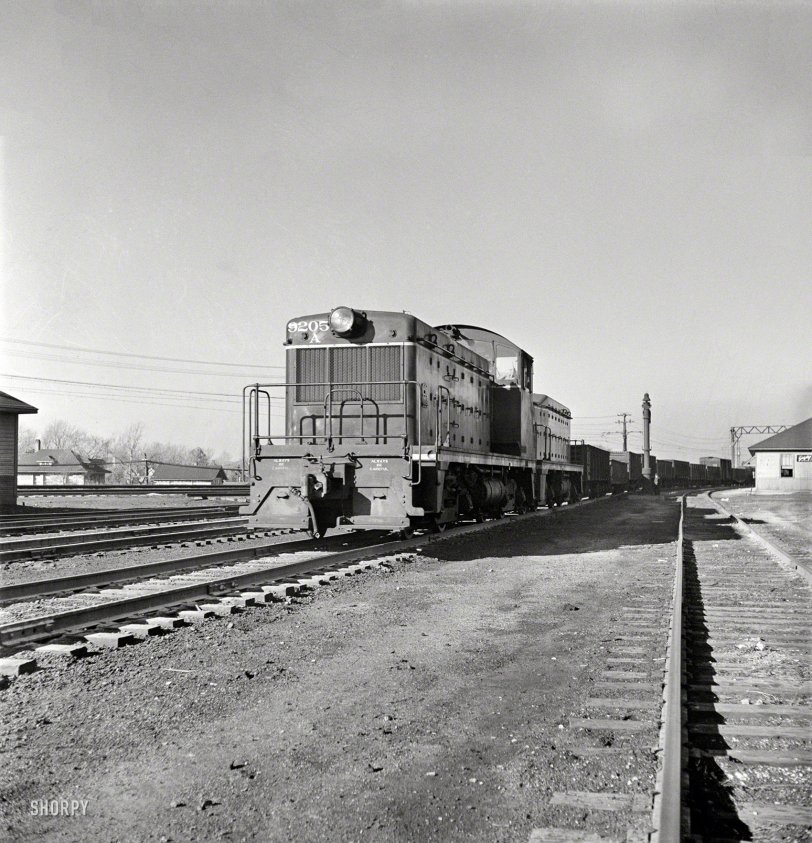


Framed or unframed, desk size to sofa size, printed by us in Arizona and Alabama since 2007. Explore now.
Shorpy is funded by you. Patreon contributors get an ad-free experience.
Learn more.

- Baldwin 62303
- Baldwin VO-1000
- Cold
- No expense spared
- Tough Guys
- Lost in Toyland
- And without gloves
- If I were a blindfolded time traveler
- Smoke Consumer Also Cooks
- Oh that stove!
- Possibly still there?
- What?!?
- $100 Reward
- Freeze Frame
- Texas Flyer wanted
- Just a Year Too Soon
- WWII -- Replacing men with women at the railroad crossing.
- Yes, Icing
- You kids drive me nuts!
- NOT An Easy Job
- I wonder
- Just add window boxes
- Icing Platform?
- Indiana Harbor Belt abides
- Freezing haze
- Corrections (for those who care)
- C&NW at Nelson
- Fallen Flags
- A dangerous job made worse
- Water Stop
Print Emporium
Always Be Careful: 1942

November 1942. "Chicago, Illinois. Giant diesel-electric locomotive at Illinois Central rail yard." The safety message comes to us courtesy of Engine 9205A. Photo by Jack Delano, Office of War Information. View full size.
TR1 Cow and calf
mountainrev's identification of this loco is correct, it's an EMD TR1. Two sets were built in April/May 1941 for the IC, rated at 1350 hp for each unit. They had the machinery of EMD's pioneering FT cab-unit freight locos in a switcher carbody. Later renumbered 1350A&B and 1351A&B, they were scrapped in 1967.
Multiple unit control technology was hardly primitive by 1941 - it had been around since the 1890s, and applied to diesel locos since the 1920s.
No more footboards.
The safety slogans are located just above the footboards, which are now illegal due to the inherent danger of crewmen riding at the end of a locomotive. Southern Pacific also used this slogan above their footboards, in addition to "Think Safety Always," "Watch Your Step," and "Look and Live."
No milk from this cow
These are Electro-Motive model NW-2 locomotives, rated at 1000 hp each. Note the trailing unit has no cab. This combination was known as a "Cow and Calf". They were kept together, with the engineer seeing equally well in both directions.
The Chesapeake and Ohio Rwy had a set of engines, nos. 9552-9554-9557 just like this, only theirs had two "calves"; thus they were called a "Cow and a Herd". [I'm not kidding...] They were sent to Baltimore where one unit was taken taken from the set and assigned to another controlling unit. They were powerful, but I didn't care for them otherwise.
Locomotive and slug
What you're seeing here is two locomotives.
Illinois Central 9205A is a 1000hp EMD NW2 built sometime after 1939. The trailing unit is almost certainly an NW2 but without a control cab and it remains attached to an "A" almost all the time.
Forward or backward?
It is usually not difficult to tell which way a steam engine is pointed, but when diesels came along things got more complicated. Out on the road, a train has a designated direction, and when it moves in that direction it is considered to be moving "forward," but what about engines doing switching, either out on the road or in a yard? They have no overall direction, they shift back and forth constantly. Hand signals, whistle/horn signals, even verbal instructions are based on either "forward" or "reverse." But looking at an engine like this one, how do you know which is which? In this case, you could tell by which half has the operating cab (the "A" unit), but that would not work in most cases.
The solution was to label one end of every diesel locomotive with the letter "F", signifying that as the "front" or "forward" end. On this engine, it would have been on the outside corner of the frame, right next to the steps, hand railings ("grab irons"), and that old, anachronistic "pole socket." I think you can just barely make it out in the full-size view.
EMD TR
Evidently with a B unit attached. It's a switcher, I wouldn't call it "giant".
Cow and Calf
An EMD TR1 cow and calf unit. One of only two pairs built by GM Electro-Motive, both purchased and used by the Illinois Central.
This locomotive
is actually 2 locomotives called a cow and calf, they are A & B, the A being the cab unit the B has no cab and is controlled by the A unit, I think IC had only two of these locomotives and were used in switching duties.
I am amazed from this photo to find out these type of diesel locomotives even existed let alone the cow/calf type.
Two engines, single cab
Directly behind the lead engine, there is what was known as a "mule". These cabless units were used when the consist dictated that more motive power was needed, but not necessarily more crew power. Novel idea, and something that couldn't be done with steam engines because of the manpower needed for each engine.
Giant?
Hardly. The units are switchers being used in duty on the hump. The cab-less unit behind is known as a slug, or less commonly as a calf, and is controlled by the other using a primitive multiple unit connection, these being the nascent days of diesel technology. Such cow/calf lash-ups never became a common sight in American railroad yards.
























On Shorpy:
Today’s Top 5